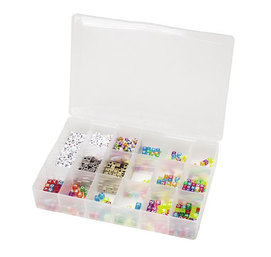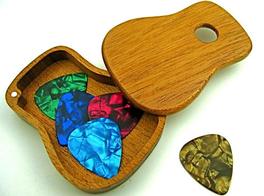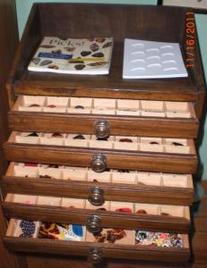Pick Storage Do's & Don'ts:
Proper guitar pick storage is a MUST for collectors!! I cannot stress enough that PLASTIC coin flips and/or coin cardboard/plastic flips are NOT appropriate for pick storage. Your guitar picks need to breathe....and if you store your picks as described above--your pick collection will slowly commit suicide(otherwise known as 'self-destructing picks'). There are many collectors who still refuse to believe this until they themselves, fall victim to the murder of their collection. I invite you to visit 'Pick Collecting Quarterly's' website for the logistics of celluloid and its' proper storage. The page can be found here: http://pickcollecting.presspublisher.us/issue-printer/summer-2010
In this article, you will learn the importance of humidity, temperature, ultraviolet light, isolation(from other celluloid picks), etc. in maintaining celluloid pick integrity. It is also important to note that common tape/adhesives are a killer of celluloid!!
Again, celluloid guitar picks need to 'breathe'. And if you are currently storing your picks in any of the methods listed above, you are slowly killing your pick collection/investment. I had fallen for the easiest and cheapest way to store about 2 years ago. Yes, the plastic 2x2 flips that can be stored in a convenient and affordable binder. I quickly learned my lesson whilst going through and looking at my vintage Japan-stamped Hercos. When I removed them from their flips to feel them in my hand? They were moist/'sweaty', smelly(like a slight vinegar odor) and broke in my hand when I applied slight pressure. This was NOT the condition by which I received them.
My solution(or so I thought)?? Plastic jewelry boxes. Cheap, affordable($2.00 each), and compartmentalized. You know...the kind of cases people store their beads in for jewelry making. Again, after about a month or two, I noted that some of my previously 'pristine' picks(mostly the 'drumshell' vintage picks) were beginning to 'cup', warp, and dry out. So I came up with another solution. I kept the lids of these containers open so that my collection could 'breathe' properly. I am still not comfortable with this method of storage and want to get my picks away from this plastic as soon as I can. I still keep my guitar picks that I received in their original display cases--IN their original 'counter display' cases, as this is a different type of plastic than the jewelry boxes. I simply keep their lids open, which seems to be working well so far. But even with this method-there is celluloid touching other celluloid, which is not healthy for them. I had purchased recently, an early 1980s D'Andrea counter display and the picks are in pristine condition...which goes to show-it's the TYPE of plastic they are kept in that keeps them either healthy or 'sick'. Counter displays/cabinets were made to store picks in---jewelry cases were made to store beads. And even though so far this storage method is working, I plan to remove them and place them in my new storage cards(cardboard), produced by a fellow collector.
I have another friend who is a fellow collector and keeps his picks in large printer's cabinets, which is working well for him. His picks can 'breathe' and are in no contact with other celluloid/plastic at all. The drawers of these cabinets are lined with felt material. A picture of such a cabinet can be seen below in the 'Do' section.
Recently, a challenge was put forth on a collecting site which I am a member of. The challenge was for someone in the pick-collecting community to come up with a solution and find the 'perfect' type of celluloid storage. I immediately thought of the vintage cardboard pick displays of the past, and Incredibly enough, fellow collector Benoit Champagne also had this idea and actually began production on the cards!! His logic? "Why try to re-invent the wheel?" And, with that thought, history was reborn! I have placed orders with Benoit twice so far(and will make many more due to my large collection) and I encourage ANY vintage/band pick collector to do the same as these are 100% SAFE for your celluloid!!!! So, from all of us collectors of celluloid? A big THANK YOU to you, Mr. Champagne!!
One more thing I would like to add. I have a bunch of 60s Herco Japan-stamped picks and they tended to get 'sweaty' every now and then. I had an idea that sprung forth from the old rice in the salt-shaker trick. I put the lot of picks in a mesh bag(the bag is actually from a fishtank filter I never used). And I added a 1/4 cup of rice and worked it through so the mixture was uniform. After that, I put them in a small wooden drawer as storage. It's been about a month and so far, so good. If this method proves to not be effective I will post here. Pictures demonstrating method below.
In this article, you will learn the importance of humidity, temperature, ultraviolet light, isolation(from other celluloid picks), etc. in maintaining celluloid pick integrity. It is also important to note that common tape/adhesives are a killer of celluloid!!
Again, celluloid guitar picks need to 'breathe'. And if you are currently storing your picks in any of the methods listed above, you are slowly killing your pick collection/investment. I had fallen for the easiest and cheapest way to store about 2 years ago. Yes, the plastic 2x2 flips that can be stored in a convenient and affordable binder. I quickly learned my lesson whilst going through and looking at my vintage Japan-stamped Hercos. When I removed them from their flips to feel them in my hand? They were moist/'sweaty', smelly(like a slight vinegar odor) and broke in my hand when I applied slight pressure. This was NOT the condition by which I received them.
My solution(or so I thought)?? Plastic jewelry boxes. Cheap, affordable($2.00 each), and compartmentalized. You know...the kind of cases people store their beads in for jewelry making. Again, after about a month or two, I noted that some of my previously 'pristine' picks(mostly the 'drumshell' vintage picks) were beginning to 'cup', warp, and dry out. So I came up with another solution. I kept the lids of these containers open so that my collection could 'breathe' properly. I am still not comfortable with this method of storage and want to get my picks away from this plastic as soon as I can. I still keep my guitar picks that I received in their original display cases--IN their original 'counter display' cases, as this is a different type of plastic than the jewelry boxes. I simply keep their lids open, which seems to be working well so far. But even with this method-there is celluloid touching other celluloid, which is not healthy for them. I had purchased recently, an early 1980s D'Andrea counter display and the picks are in pristine condition...which goes to show-it's the TYPE of plastic they are kept in that keeps them either healthy or 'sick'. Counter displays/cabinets were made to store picks in---jewelry cases were made to store beads. And even though so far this storage method is working, I plan to remove them and place them in my new storage cards(cardboard), produced by a fellow collector.
I have another friend who is a fellow collector and keeps his picks in large printer's cabinets, which is working well for him. His picks can 'breathe' and are in no contact with other celluloid/plastic at all. The drawers of these cabinets are lined with felt material. A picture of such a cabinet can be seen below in the 'Do' section.
Recently, a challenge was put forth on a collecting site which I am a member of. The challenge was for someone in the pick-collecting community to come up with a solution and find the 'perfect' type of celluloid storage. I immediately thought of the vintage cardboard pick displays of the past, and Incredibly enough, fellow collector Benoit Champagne also had this idea and actually began production on the cards!! His logic? "Why try to re-invent the wheel?" And, with that thought, history was reborn! I have placed orders with Benoit twice so far(and will make many more due to my large collection) and I encourage ANY vintage/band pick collector to do the same as these are 100% SAFE for your celluloid!!!! So, from all of us collectors of celluloid? A big THANK YOU to you, Mr. Champagne!!
One more thing I would like to add. I have a bunch of 60s Herco Japan-stamped picks and they tended to get 'sweaty' every now and then. I had an idea that sprung forth from the old rice in the salt-shaker trick. I put the lot of picks in a mesh bag(the bag is actually from a fishtank filter I never used). And I added a 1/4 cup of rice and worked it through so the mixture was uniform. After that, I put them in a small wooden drawer as storage. It's been about a month and so far, so good. If this method proves to not be effective I will post here. Pictures demonstrating method below.
Categories:
DON'T!!!:

Also created for coin storage, these coin 'flips' have no place in the world of guitar pick storage, as they too, prevent free air flow over your guitar picks. I still see TONS of collectors using these for storage and it causes me to cringe. I've known collectors who stick tiny pin pricks into the plastic, thinking these will preserve their celluloid, only to find they have killed their picks regardless. Again? DON'T DO IT!!
DO!!!:

I never recommend plastic as storage for ANY celluloid guitar pick, though I still keep a few Gibsons in this original counter display/cabinet tray. It is still not efficient, as I can only keep one pick in each compartment and have to leave the lid constantly open. Even so, I consider this type of storage a 'DO', as the picks I received within it were STILL in pristine condition since the 1960s-70s.

Fellow collector, Benoit Champagne's method of storage. As time has proven with vintage pick cards, this method is quite acceptable and encouraged. This is considered by many to be the 'perfect' method of celluloid storage. Each card accommodates 35 guitar picks,. Various guitar pick shapes can be stored on these cards, and it is INDEED an affordable method of storage!! Picks can still be displayed in a binder and are able to breathe without touching eachother. DO!!!









